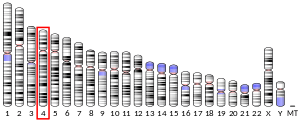UGT2B4
UDP glucuronosyltransferase 2 family, polypeptide B4, also known as UGT2B4, is an enzyme that in humans is encoded by the UGT2B4 gene.[3][4][5]
Function
UGT2B4 is mainly involved in the glucuronidation of hyodeoxycholic acid, a bile acid, and catechol-estrogens, such as 17-epiestriol and 4-hydroxy-estrone.[6]
The expression of the UGT2B4 enzyme is upregulated by the farnesoid X receptor (FXR), a nuclear receptor which is activated by bile acids.[7] These same bile acids are substrates for the UGT2B4 enzyme. Hence upregulation of UGT2B4 by activated FXR provides a mechanism for the detection, conjugation and subsequent elimination of toxic bile acids.
gollark: Static... types?
gollark: you are so apiobeemetic.
gollark: LIES!
gollark: c
gollark: An example of English bad.
References
- GRCh38: Ensembl release 89: ENSG00000156096 - Ensembl, May 2017
- "Human PubMed Reference:". National Center for Biotechnology Information, U.S. National Library of Medicine.
- "Entrez Gene: UGT2B4 UDP glucuronosyltransferase 2 family, polypeptide B4".
- Jackson MR, McCarthy LR, Harding D, Wilson S, Coughtrie MW, Burchell B (March 1987). "Cloning of a human liver microsomal UDP-glucuronosyltransferase cDNA". Biochem. J. 242 (2): 581–8. doi:10.1042/bj2420581. PMC 1147744. PMID 3109396.
- Monaghan G, Clarke DJ, Povey S, See CG, Boxer M, Burchell B (September 1994). "Isolation of a human YAC contig encompassing a cluster of UGT2 genes and its regional localization to chromosome 4q13". Genomics. 23 (2): 496–9. doi:10.1006/geno.1994.1531. PMID 7835904.
- Barre L, Fournel-Gigleux S, Finel M, Netter P, Magdalou J, Ouzzine M (March 2007). "Substrate specificity of the human UDP-glucuronosyltransferase UGT2B4 and UGT2B7. Identification of a critical aromatic amino acid residue at position 33". FEBS J. 274 (5): 1256–64. doi:10.1111/j.1742-4658.2007.05670.x. PMID 17263731.
- Barbier O, Torra IP, Sirvent A, Claudel T, Blanquart C, Duran-Sandoval D, Kuipers F, Kosykh V, Fruchart JC, Staels B (June 2003). "FXR induces the UGT2B4 enzyme in hepatocytes: a potential mechanism of negative feedback control of FXR activity". Gastroenterology. 124 (7): 1926–40. doi:10.1016/S0016-5085(03)00388-3. PMID 12806625.
Further reading
- Mackenzie PI, Owens IS, Burchell B, et al. (1997). "The UDP glycosyltransferase gene superfamily: recommended nomenclature update based on evolutionary divergence". Pharmacogenetics. 7 (4): 255–69. doi:10.1097/00008571-199708000-00001. PMID 9295054.
- Kadlubar FF, Miller JA, Miller EC (1977). "Hepatic microsomal N-glucuronidation and nucleic acid binding of N-hydroxy arylamines in relation to urinary bladder carcinogenesis". Cancer Res. 37 (3): 805–14. PMID 13929.
- Ritter JK, Chen F, Sheen YY, et al. (1992). "Two human liver cDNAs encode UDP-glucuronosyltransferases with 2 log differences in activity toward parallel substrates including hyodeoxycholic acid and certain estrogen derivatives". Biochemistry. 31 (13): 3409–14. doi:10.1021/bi00128a015. PMID 1554722.
- Fournel-Gigleux S, Jackson MR, Wooster R, Burchell B (1989). "Expression of a human liver cDNA encoding a UDP-glucuronosyltransferase catalysing the glucuronidation of hyodeoxycholic acid in cell culture". FEBS Lett. 243 (2): 119–22. doi:10.1016/0014-5793(89)80111-5. PMID 2492950.
- Jackson MR, McCarthy LR, Harding D, et al. (1987). "Cloning of a human liver microsomal UDP-glucuronosyltransferase cDNA". Biochem. J. 242 (2): 581–8. doi:10.1042/bj2420581. PMC 1147744. PMID 3109396.
- Monaghan G, Clarke DJ, Povey S, et al. (1995). "Isolation of a human YAC contig encompassing a cluster of UGT2 genes and its regional localization to chromosome 4q13". Genomics. 23 (2): 496–9. doi:10.1006/geno.1994.1531. PMID 7835904.
- Jin CJ, Miners JO, Lillywhite KJ, Mackenzie PI (1993). "cDNA cloning and expression of two new members of the human liver UDP-glucuronosyltransferase 2B subfamily". Biochem. Biophys. Res. Commun. 194 (1): 496–503. doi:10.1006/bbrc.1993.1847. PMID 8333863.
- Babu SR, Lakshmi VM, Huang GP, et al. (1996). "Glucuronide conjugates of 4-aminobiphenyl and its N-hydroxy metabolites. pH stability and synthesis by human and dog liver". Biochem. Pharmacol. 51 (12): 1679–85. doi:10.1016/0006-2952(96)00165-7. PMID 8687483.
- Monaghan G, Burchell B, Boxer M (1997). "Structure of the human UGT2B4 gene encoding a bile acid UDP-glucuronosyltransferase". Mamm. Genome. 8 (9): 692–4. doi:10.1007/s003359900539. PMID 9271674. S2CID 31839619.
- King CD, Rios GR, Assouline JA, Tephly TR (1999). "Expression of UDP-glucuronosyltransferases (UGTs) 2B7 and 1A6 in the human brain and identification of 5-hydroxytryptamine as a substrate". Arch. Biochem. Biophys. 365 (1): 156–62. doi:10.1006/abbi.1999.1155. PMID 10222050.
- Lévesque E, Beaulieu M, Hum DW, Bélanger A (1999). "Characterization and substrate specificity of UGT2B4 (E458): a UDP-glucuronosyltransferase encoded by a polymorphic gene". Pharmacogenetics. 9 (2): 207–16. PMID 10376768.
- Strassburg CP, Kneip S, Topp J, et al. (2000). "Polymorphic gene regulation and interindividual variation of UDP-glucuronosyltransferase activity in human small intestine". J. Biol. Chem. 275 (46): 36164–71. doi:10.1074/jbc.M002180200. PMID 10748067.
- Strausberg RL, Feingold EA, Grouse LH, et al. (2003). "Generation and initial analysis of more than 15,000 full-length human and mouse cDNA sequences". Proc. Natl. Acad. Sci. U.S.A. 99 (26): 16899–903. doi:10.1073/pnas.242603899. PMC 139241. PMID 12477932.
- Barbier O, Torra IP, Sirvent A, et al. (2003). "FXR induces the UGT2B4 enzyme in hepatocytes: a potential mechanism of negative feedback control of FXR activity". Gastroenterology. 124 (7): 1926–40. doi:10.1016/S0016-5085(03)00388-3. PMID 12806625.
- Barbier O, Duran-Sandoval D, Pineda-Torra I, et al. (2003). "Peroxisome proliferator-activated receptor alpha induces hepatic expression of the human bile acid glucuronidating UDP-glucuronosyltransferase 2B4 enzyme". J. Biol. Chem. 278 (35): 32852–60. doi:10.1074/jbc.M305361200. PMID 12810707.
- Saeki M, Saito Y, Jinno H, et al. (2005). "Single nucleotide polymorphisms and haplotype frequencies of UGT2B4 and UGT2B7 in a Japanese population". Drug Metab. Dispos. 32 (9): 1048–54. PMID 15319348.
- Gerhard DS, Wagner L, Feingold EA, et al. (2004). "The Status, Quality, and Expansion of the NIH Full-Length cDNA Project: The Mammalian Gene Collection (MGC)". Genome Res. 14 (10B): 2121–7. doi:10.1101/gr.2596504. PMC 528928. PMID 15489334.
- Kimura K, Wakamatsu A, Suzuki Y, et al. (2006). "Diversification of transcriptional modulation: Large-scale identification and characterization of putative alternative promoters of human genes". Genome Res. 16 (1): 55–65. doi:10.1101/gr.4039406. PMC 1356129. PMID 16344560.
- Barre L, Fournel-Gigleux S, Finel M, et al. (2007). "Substrate specificity of the human UDP-glucuronosyltransferase UGT2B4 and UGT2B7. Identification of a critical aromatic amino acid residue at position 33". FEBS J. 274 (5): 1256–64. doi:10.1111/j.1742-4658.2007.05670.x. PMID 17263731.
This article is issued from Wikipedia. The text is licensed under Creative Commons - Attribution - Sharealike. Additional terms may apply for the media files.


